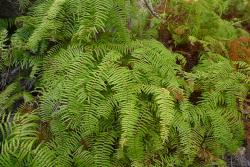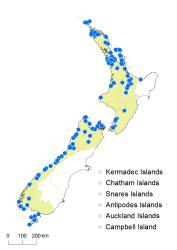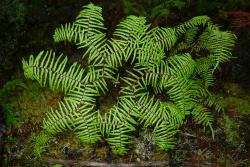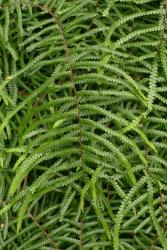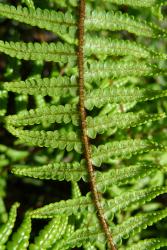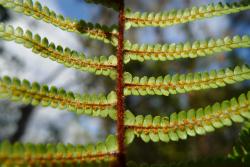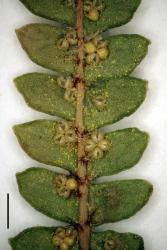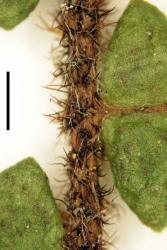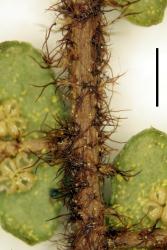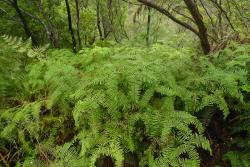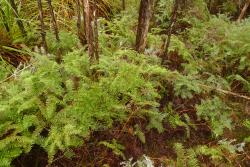- ≡ Mertensia microphylla (R.Br.) Kaulf., Enum. Filic. 41 (1824)
- ≡ Calymella microphylla (R.Br.) C.Presl, Tent. Pterid. 49 (1836)
- ≡ Gleicheniastrum microphyllum (R.Br.) C.Presl, Gefässbündel Farrn 30 (1847)
- ≡ Gleichenia circinnata var. microphylla (R.Br.) Maiden & Betche, Census N.S.W. Pl. 6 (1916)
- ≡ Platyzoma recurvum Desv., Mém. Soc. Linn. Paris 6: 199 (1827) nom. nov. pro Gleichenia microphylla R.Br. 1810 (non Platyzoma microphyllum R.Br. 1810)
- = Gleichenia semivestita Labill., Sert. Austro-Caledon. 8, t. 11 (1824)
- ≡ Gleicheniastrum semivestitum (Labill.) C.Presl, Gefässbündel Farrn 30 (1847)
- ≡ Gleichenia circinnata var. semivestita (Labill.) T.Moore, Index Fil. 374 (1862)
- ≡ Gleichenia microphylla var. semivestita (Labill.) Alderw., Malayan Ferns Fern Allies 80 (1917)
- ≡ Calymella semivestita (Labill.) Ching, Sunyatsenia 5: 288 (1940)
- ≡ Gleicheniastrum microphyllum var. semivestitum (Labill.) Nakai, Bull. Natl. Sci. Mus. 29: 45 (1950)
- = Gleichenia patens Colenso, Trans. & Proc. New Zealand Inst. 20: 212 (1888)
- ≡ Gleichenia circinnata var. patens (Colenso) Domin, Biblioth. Bot. 20(85): 202 (1913)
- = Gleichenia circinnata var. concolor Domin, Biblioth. Bot. 20(85): 202 (1913)
Rhizomes long-creeping, 1.5–3 mm diameter; rhizome scales lanceate or ovate, 1.2–2.6 mm long, 0.5–1.0 mm wide, brown, setose, mixed with stellate scales. Fronds 110–1600 mm long. Stipes 65–1100 (rarely 25) mm long, distally scaly. Laminae 100–520+ (rarely 35) mm long, 80–520+ (rarely 30) mm wide. Rachis buds not extending or extending 1–2 (rarely 3) times; rachis bud scales acicular or lanceate, 0.8–2.6 mm long, 0.2–0.6 mm wide, brown, ciliate and apically setose. Rachis buds usually with single or paired accessory leaflets near base of each proximal-most costae; these accessory leaflets often proximally branched. Pinnae 40–370 mm long, 30–290 mm wide; with 1–3 (rarely 0 or 4) successive pseudodichotomous forks (excluding growth from pinna buds); pinna buds occasionally extending once (rarely 2–3 times). Proximal-most costae 14–70 mm long, persistently scaly. γ costae (where not proximal-most costa) 25–75 mm long, with 2–11 pairs of costal leaflets (excluding accessory leaflets around bud). β costae 30–390 (rarely 12) mm long, with 5–38 pairs of ultimate leaflets; adaxially with dense dark-brown or red-brown stellate scales with patent or divergent branches; abaxially with red-brown stellate scales with branches 400–1000 µm long, mixed with lanceate, red-brown or pale, ciliate and/or setose scales, 260–1200 µm long, 80–260 µm wide. Longest ultimate leaflets 20–110 (rarely 8) mm long, with 18–62 (rarely 9) pairs of ultimate segments. α costae adaxially glabrous or with scattered, pale, branched, hair-like scales; abaxially with pale, curly, branched, hair-like scales, proximal only or scattered if percurrent. Ultimate segments 1.3–2.7 mm long, 0.8–2.0 mm wide, ovate or deltate, complanate or recurved, at least some apices cuspidate (otherwise obtuse); adaxially green, glabrous, complanate; abaxially green, glabrous. Sori superficial, each with 2–4 (rarely 5) sporangia. Spores 37.7–41.4 µm long, 41.1–45.7 µm wide (6 populations).
Gleichenia microphylla has complanate or recurved ultimate segments with green abaxial surfaces, and at least some of them have cuspidate (± triangular) apices. The indumentum on the abaxial surface of the β costae is dominated by stellate scales with stiffly patent branches. Most sori have more than 2 sporangia. It thus differs substantially from G. dicarpa, which has pouched or recurved ultimate segments with white or glaucous abaxial surfaces and rounded apices, an indumentum on the abaxial surface of the β costae comprising an intergrading mix of ciliate ovate scales and stellate scales, and sori mostly with 2 sporangia. However, putative hybrids combining the character states of both species and/or with intermediate character states are widespread and fairly common.
North Island: Northland, Auckland, Volcanic Plateau, Taranaki, Southern North Island.
South Island: Western Nelson, Sounds-Nelson, Marlborough, Westland, Fiordland, Southland .
Stewart Island.
Altitudinal range: 5–760 m.
Gleichenia microphylla is widespread from the far north of the North Island to Stewart Island, but is largely confined to areas west of the axial ranges of the North and South Islands. It occurs from near sea level to 600 m above sea level, reaching 760 m on Stewart Island.
Also Australia (New South Wales, South Australia, Victoria, Tasmania). Some authors (e.g. Chinnock & Bell 1998) have attributed Gleichenia microphylla to New Caledonia, but this is not supported by recent collections (see Notes). The attribution of plants outside Australasia (e.g., Malesia) to G. microphylla requires examination (see Notes).
Gleichenia microphylla frequently occurs in Leptospermum/Kunzea and other scrub, as well as open situations within other forest types (kauri, podocarp, beech, broadleaved, and/or plantation), particularly along natural or human-induced margins (e.g., along roads and tracks). It occurs in or around swamps and other wet ground, but extends to ridges, and to rocky and poor substrates (e.g., clay, ultrabasic). Gleichenia microphylla tends to occupy more shaded and drier sites than G. dicarpa, but they often co-occur.
Morphological intermediates between Gleichenia microphylla and G. dicarpa are common (e.g., plants with ± complanate ultimate segments that are glaucous on their abaxial surface). These are potentially hybrids and that is how they are treated here (see Gleichenia ×punctulata).
n = 20 (Brownlie 1961)
One of the syntypes of Gleichenia patens Colenso, WELT P002911, has pinna buds that extend to an unusual degree. This is likely the basis of Cheeseman’s opinion (1925, p.85) that Gleichenia patens is "an excessively proliferous state".
Gleichenia semivestita Labill. is a synonym of G. microphylla (Perrie & Brownsey 2015). The former was described from New Caledonia. This may be the source of the attribution of G. microphylla to New Caledonia. However, Brownlie (1969) did not record it, and modern collections do not support the presence of G. microphylla in New Caledonia. Labillardière (1824) may have mistakenly attributed Australian material of G. microphylla to New Caledonia.
Malesian plants have also been attributed to Gleichenia microphylla (Holttum 1959). However, this needs re-examination because at least some of these plants differ from Australian and New Zealand material in having patently-branched stellate scales ± percurrent on the β costae (Malaysia, Mount Ophir, Shah 3604 & Ahmad, CHR 304103), and in having glaucous abaxial surfaces on the ultimate segments (Piggot 1988).



